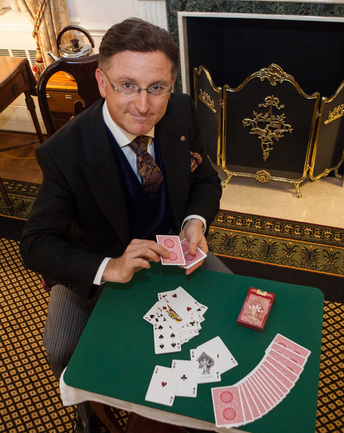 Steve Cohen with Tycoons, at the Waldorf Astoria. Photo: ©2014, Magic in New York.
Steve Cohen with Tycoons, at the Waldorf Astoria. Photo: ©2014, Magic in New York. 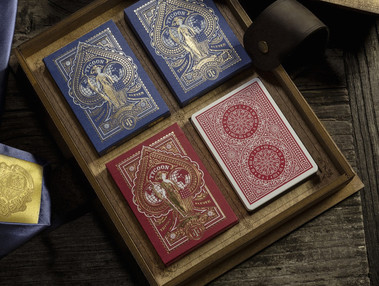 Photo courtesy Theory11
Photo courtesy Theory11 I’m a fan of vintage looking playing cards. Many of the new custom cards that people are releasing look too new or too modern for my purposes. Because my show at the Waldorf Astoria hotel is a throwback to the Victorian age of magic, I wanted to have cards that would match that style. The only cards that I’d enjoyed using were Bicycle Fan Back cards. Although those cards look great, and they call back the memory of a time gone by, the tuck case has the word “Vintage” written on it and includes a printed advertisement about the vintage back design. In fact, I have it here. It reads, "The Bicycle vintage design series recreates historic Bicycle playing card designs from the last one hundred and twenty years. Start your collection today." It’s like wearing a vintage t-shirt that reads, ‘This is a vintage t-shirt.’
It seems so gratuitous, and doesn’t really provide the actual feel of a vintage item because you know it’s a reproduction. Although I really loved these Bicycle Fan Back cards, the tuck cases didn’t appeal to me at all. I wanted cards that looked great, that felt great, and that matched the venue where I perform -- the Waldorf Astoria. The show is now in its fourteenth year, going into the fifteenth year, and half a million people have come to see the show. It’s really running strong. I wanted to honor the tradition of having a really special evening out for my guests and one way I could do that was by adding something, my contribution, which was to create a new deck of cards.
The fact is that the artist must pay attention to every detail, and I think the audience picks up on these decisions on a subconscious level. I decide upon so many details that the audience may never be aware of, but these details contribute to the whole of my artistic vision. The audience may not pick up on all of the details, but for me it contributes to the entire package, the entire experience, so I’m living the experience as well as the audience. If I’m using a deck of cards that doesn’t match the style of the show, the audience may not overtly pick up on it, but I would. This ultimately affects my presentation.
Tycoon cards actually have a personal meaning as well. I first became seriously interested in card magic when I saw Juan Tamariz perform at FFFF twenty-five years ago, and at that show he used Fournier brand cards, manufactured in Spain. We licensed the Fournier card faces for use on the Tycoon deck, and so for me personally this deck brings me back to my roots and makes me feel like I’m using the right tool for the job.
It’s not always about the audience’s perception of it. Sometimes you do something for yourself as the artist to make you feel like you’re doing your best possible job. I wanted cards that looked good and felt good. I wanted the tuck case to look like it matched the venue that I’m performing in. These are all things that make me feel like I can do my best job. Once I feel comfortable, the audience can sense that.
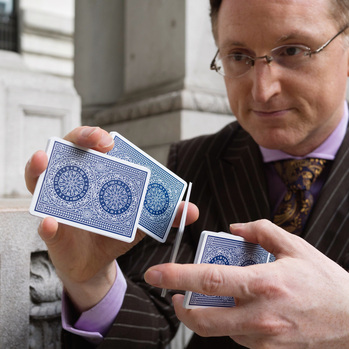 Photo courtesy Steve Cohen
Photo courtesy Steve Cohen I’ve been friends with Jonathan Bayme, the president of Theory11, for about five years, and several years back he asked me if I wanted to create a custom deck of cards for my show. At first I really had no interest; I thought there was really no need for it because I had a large stock of Bicycle Fan Backs. Then I started to run low on Fan Backs and thought, rather than buying a new supply of cards, perhaps I should create my own.
So I looked closer at the graphics and imagery that are present in the Waldorf Astoria in New York. I’ve always loved the Art Deco bas relief images found on the walls and along the doorways. I’m at the Waldorf three days every week, sometimes four days a week. Those graphics have a real appeal to me, and I thought, ‘Wouldn’t it be interesting to take these motifs and apply them to a deck of cards?’ Every time I walked past certain pillars, sconces or elevator doors, I thought, ‘Hmmm, that would look great on a deck of cards.’ Suddenly the concept started to click and I contacted Jonathan Bayme. I said, ‘You know, I think I want to go ahead and actually make that deck of cards now.’
It took us a year from that moment until the time we had a finished product. Actually even more than that, probably about 18 months, because we worked with a designer, and the designer came back with ideas that needed multiple tweaks. It was not a quick process. This was a very well-thought-out deck. It handles really well. The design suits me really well. I could imagine someone who doesn’t perform in my type of venue might look at these and say that Tycoons are too ornate or don’t really match their own style. That’s fine. Everyone should pick a style that suits them self. This deck really speaks to me. [Interview Continues]
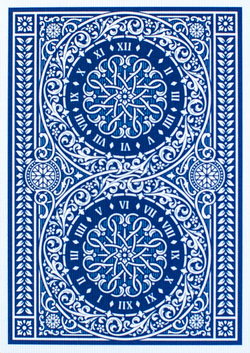
I worked with an illustrator who specializes in cigar box design. If you look at cigar box labels, you’ll see that they contain very intricate, fine engraving work. It’s a very unique style of line art. I provided the illustrator with a lot of reference material, particularly with photographs of the interior of the Waldorf Astoria. I also provided photos of a beautiful stained glass ceiling that I found in Paris at the Galeries Lafayette department store. In addition, I am a watch collector, so I explained that I wanted the face of a clock to be represented on the cards. After I provided all these images, the illustrator came back with a first pass at the design. Then we needed to tweak the design and flesh it out into a more refined design. For example, in the first pass, there were two circles on the back design, similar to the circles found on a Bicycle Rider Back deck. The circles were touching each other tangentially, forming a figure eight. And I said ‘No, this design seems too simple, so let’s have the circles interlink with each other.’ If you look at the final design used on Tycoons, you’ll see that the two back design circles are interlinked with each other like linking rings. Also, there’s only a certain level of intricacy you can get before the ink starts to become too dense. I had another version of this design where there were many small interlocking keys located inside the clock faces. That design looked beautiful on a monitor but if you tried to print it and subsequently look at it from a distance the intricacies were impossible for the eye to catch. You have to try to get the design to a level where it appears both intricate and beautiful without going too far beyond what the eye can process.
Another choice to make is “border width.” There’s a recent trend to print a larger back design with narrower white borders versus traditional-width borders. The smaller border is about 3 millimeters as opposed to 5 millimeters for standard width. The extra millimeter or two allowed Tycoons to have a more intricate design. With narrow borders, however, off-centered printing becomes strikingly obvious. Bicycle cards sometimes are misprinted or slightly shifted. If such a shift occurs on a narrow-bordered deck it would look awful because the printing would go right off to the edge. So we had to be really careful with the registry of the deck.
Yeah, in the past U. S. Playing Cards’ track record wasn't so great in terms of perfect registration.
I really wanted Tycoons to be perfect so we went through things with a fine-toothed comb. We printed 15,000 decks and when you print that many decks, you’re able to use U. S. Playing Cards Company’s best printing presses. For them that’s a respectable quantity. When you’re dealing with a smaller quantity order, they might put you on a digital press, and if they do that then you’re ending up with something that may not be as good a quality card or as good a quality product. We really used the best quality everything for this, including the boxes. If you look at the tuck cases -- in the world of playing cards they don’t call them card boxes, they call them tuck cases -- we have gold foil, we have hot stamping, we have everything so perfectly printed on here. The U. S. Playing Card Company steps up to the game when you give them all of the right instructions. I personally picked the paper for the boxes. These are the most expensive boxes that have been produced, to my knowledge, by Theory11 and also by the U. S. Playing Card Company. It’s very expensive paper and they did a perfect job with them. But you have to give them perfect instructions in order to do a better job.
In the end, in respect to the back design, did the clocks come from something you found at the Waldorf or from some other reference material.
Like I said, I gave several reference points to my designer, the one who does the cigar box design and I said I’d like to have a clock, I’d like to have this type of filigree work, I’d like to have these type of leaves on the edges, I’d like to have stained glass circles at certain parts of it. I just gave directions and then he put things together. We had to go through several iterations of that design -- changing it, tweaking it, polishing it.
So it wasn’t something that literally mimics a pre-existing image. It was a creation coming from these various references sources you gave the designer.
Right. It’s funny, there are now so many people designing custom cards, and they do it in a very cursory way. They say, ok, I’ve got Photoshop and I’m sure I can put something together. And they release a deck or they put it on Kickstarter, and these decks look, shall we say, homespun. They look homemade. There’s a certain degree of professionalism that comes from working with a professional. You really can’t do it yourself. If you’re a magician and you say I’d like to have my own custom deck, if you try to do it yourself, you’re most likely going to end up with something that looks less than stellar. It makes sense to go to a pro and work with the pro because they bring certain elements to the table that you personally couldn’t unless you had that certain training. Working with a professional designer was the right choice for me.
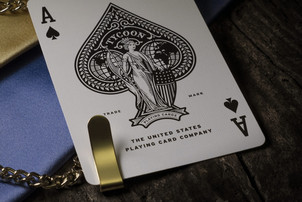 Photo courtesy Theory11
Photo courtesy Theory11 It’s a relatively new acquisition, that U. S. Playing Card Company has purchased Fournier. Having said that, we were not able to simply use those faces from the Fournier cards as a matter of course. We actually pay a licensing fee per deck. So every time that we print one deck, we’re actually paying for the use of the Fournier faces.
We were not permitted to change the composition of Fournier cards. The only details we were permitted to change were the Ace of Spades, and the jokers. On the Tycoon deck, the Ace of Spades and Jokers are our original designs. I really like the flesh tone on Fournier court cards. That was one of the draws for me. The Jacks, Queens, and Kings, all of the court cards, have a nice flesh tone that you don’t see on American cards. So it really makes them look unique and classy. People may not recognize it and if you don’t point it out, they probably wouldn’t recognize it. However when they look closely they see that Tycoons look very different than the standard cards they might have in their drawer at home. When I’m performing in my environment at the Waldorf, Tycoons really fit in because the cards look very elegant. They’re like pieces of art.
And the jokers? How did you come to the decision of how to depict the joker?
I said to the designer, ‘Show me a Joker wearing a top hat.’ He came back with a joker wearing a top hat, but sitting cross-legged on the ground. That wasn’t quite right, so I sent him a picture of me wearing my three-piece suit. The final Joker design is not obviously me, but he’s wearing clothes similar to what I would wear, aside from the yellow pants! It’s kind of a mash-up between what I wear at my Chamber Magic shows plus the Monopoly man.
When I looked at it I thought right away it resembled you.
When I was a teenager I used to buy Hoyle cards, which had one color joker and one that was black and white. This is an interesting combination if you’re a magician and you want to perform a color changing joker effect, which I remember doing when I was younger. Transforming a black and white joker into a colored joker is a great trick, and I can perform that again with Tycoons. Jonathan Bayme from Theory11 asked, ‘What happens if someone wants two identical jokers?’ Well, if you want two identical jokers, buy two decks!
Let me tell you more about the process. After submitting the artwork to U.S. Playing Card Company, you must simply wait until they tell you they are actually printing. No matter how many times you call to inquire, until they tell you “we’re printing,” they’re not printing. It’s a very long process – hurry up and wait! They print the tuck cases first. The reason for this is if they don’t have any containers to insert the playing cards into, they can’t store the printed cards due to humidity and air quality. So, they print the tuck cases first. After the cases are printed, folded, and glued, then they print the cards. I forget what the volume is but they print the cards incredibly fast. They printed 15,000 decks in something like an hour. It’s amazing.
Was there anything unexpected that you had to deal with? Is there anything that other people could learn from your experience working on the cards?
The question you should ask yourself if you’re thinking of producing a custom deck is ‘what is the purpose behind it?’ What is the reason that you wouldn’t want to use an existing deck of cards? So many new designs have been released that it is almost unnecessary to make a new deck. If you’re doing it purely for vanity purposes, there is certainly nothing wrong with that. I produced Tycoons as a tool to be used in my show. I never thought of Tycoons as a way to make a lot of money or to make myself look great. I didn’t produce them to make a splash in the marketplace. I wanted a custom deck of cards that matched my environment and the show that I perform.
If you’re an average magician there’s no reason why you need unusual cards. Tally Ho cards, Bicycles, and Bees are classics for a reason. And most audience members are familiar with these brands so they don’t question them. At my own shows, people occasionally approach me, look at the cards and say, ‘Wow, those are really nice -- are they special cards?’ I say no, and give them the deck. I explain that they’re custom designed cards. I designed them, but they’re not trick cards. That’s the one trap that you fall into. If you use cards that people aren’t familiar with, they may question them and think that they must be a trick deck because they’ve never seen that design before.
Let’s just shift gears slightly. This whole collectible or customized deck market sprang up and there was a wave of popularity. I wonder what you feel about where things are now. I’m starting to feel a little oversaturated with it or maybe overwhelmed is a better way of putting it.
You can print small quantities of decks now, thanks to printing technology. In the past you had to print large runs. If you print a large run of cards, you’re obviously committing to a certain design or style. But these days you can print smaller batches, and because of that people are experimenting. They’re printing lots of unique colors and new designs. Like you said there’s an over-saturation of these specialized cards at the present time. It really boils down to marketing. Some of the guys who print customized decks are really quite excellent marketers. They make each deck seem so desirable by pitching certain qualities of them. ‘These cards are ideal for cardistry.’ ‘These cards have the perfect rigidity for double lifts.’ ‘These cards are better for springing.’ Unfortunately many young magicians are susceptible to this marketing, and feel enticed to buy each new deck that comes out. I met a high school student who is an amateur magician and he owns about 50 different decks of cards. He proudly showed me each deck, explaining the special qualities of each deck. It was like someone showing off their stamp collection.
It may mean something to the collector, but I think that the audience watching a performance of card magic couldn’t care whether it was a Viper deck, a Centurion deck, a Tycoon deck, or a whatever deck! The audience watching your card magic doesn’t care about the back design as much as the way you make them feel. The salesmanship necessary to convince impressionably young magicians to buy specific decks is simply a commercial exercise that won’t make their magic any better.
When I first noticed this in the magic world I thought it was parallel to the comic book collecting market.
It is. The secondary market for some of these decks is pretty incredible. Some decks that are printed as a limited edition are snapped up by collectors in all corners of the world. Later on these collectors list the decks on eBay for a couple hundred dollars each. If a six or seven dollar item is suddenly selling for a couple hundred dollars, those collectors make a considerable return on their original purchase. I remember when I was a young magician I went out to Las Vegas and went to Jerry’s Nugget. I bought a couple dozen decks of Jerry’s Nugget cards at a dollar per deck. Now you find Jerry’s Nugget cards online for a couple hundred dollars per deck. I unfortunately used up my supply of Jerry’s Nuggets when I was younger. That’s the difference with Tycoon cards. We printed a lot. We printed 15,000 decks. In two months we sold almost all of them, worldwide. We’ve sold nearly all the decks and we’re now ready to reprint.
Who sold them? Is it magic stores?
Well, the cards have been ordered by a well-known retail chain that will sell them nationally early next year. Ironically Tycoons are stacked in the Tamariz Mnemonica order, with the Ace of Spades cut to the face, which means that some random person might buy a deck of Tycoon cards, open the box and have the deck pre-set in an important order for a magician. If people ask why the cards aren’t in new-deck order, we explain, tongue-in-cheek, that the cards are "so luxurious that we’ve pre-mixed them for you.”
What it also means is that if you’re a magician you can buy this deck, open it up, and be ready to go for any sort of memorized deck work. The deck comes straight out of the box at the store that way.
It’s a kind of cool possibility. I do think more to the point is that if you’re doing a magic show, you could have the deck sealed and open it and then …..do you start with the deck sealed?
When I do my Chamber Magic show the decks are already opened. However I wanted the cards to be pre-arranged because I often use the Mnemonica stack in my private performances. I wanted to be able to open up a brand new deck, remove the jokers and advertising cards, allowing everyone to see the Ace of Spades at the face of the deck like it should be, and then give the cards a full deck false shuffle. After cutting the nine of diamonds to the bottom, you can fan out the cards and it looks like a genuinely shuffled deck. I use this ruse all the time.
The one feature of the deck that we haven’t so far discussed is that you included a double backed card.
Right. When I give the deck to laymen, I just tell them that’s a book mark. They think of it as an interesting design feature. They can’t imagine that this card could be a gimmick. I actually use the double backer in one of my tricks, so for me it’s actually a functional card. I thought of also making a red/blue double backer. I suspect, though that laymen would find that card to be suspicious. We printed so many of them, and we’re aware that laymen are going to have these cards in their houses. We didn’t want to provide them with obviously gimmicked cards. But in my opinion, the double backer that comes in the Tycoon deck wouldn’t be too unsettling for the average layman. They often just discard it anyway.
I have a new idea for the next printing of Tycoons -- a subtle one way back design. On the current back design there’s a clock face containing Roman numerals from one through twelve. If you look at the number “four” on any watch or clock containing Roman numerals, the four is always represented as IIII. But if you think about your knowledge of Roman numerals, that’s not the correct way to write the number four. It should be represented as IV. So it’s an odd feature that clocks and watches worldwide don’t use IV but do use IIII. For the next version of Tycoons, we’re going to reprint them so that one clock face will show IIII in the position of four and the other clock face will be IV. This disparity allows for a nice, subtle, one-way back design.
Getting back to the specialized card market for a minute. Do you have any thought about where this is going to go in the future. The Expert Playing Card Company is very focused on exploring the technology and finding new kinds of paper and printing techniques for their decks. Companies like Theory11, Ellusionist, Blue Crown, Kings Wild Project, and numerous others seem to be developing new designs and issuing specialized decks every day. As intriguing and beautiful as some of these are, I wonder if the market is going to support all of this.
My opinion is that there will always be someone who wants the latest. For example, I had a neighbor who traded in his old car from the previous year and trades up for the newest one. He does this every single year, and there is nothing wrong with that. Because there are people who just want to have the latest. It’s the same philosophy as Apple. Fans feel that they need the newest iPad or the latest iPhone. There are certain people who are die-hard fans and are going to want to have it. But it’s really hard to come up with enough superlatives for a new deck for example to say why this is so much better than the previous one that you already have. So you’re going to find that there’s a market for true collectors – people who just want to have one of anything but as a functional prop, in other words, someone who uses cards for their show, they’re going to say, 'that’s nice but I already have something that does the job, something functional.'
A professional magician most likely won’t need one of each. So, it’s the hobby collector who supports these projects, and I don’t know how many hobby collectors there are. It’s a good question. The people who are marketing new cards know how to produce beautiful decks and they’re probably going to continue making more.
As a consumer I can confirm that these companies are persuasive. I don’t know why it is that gold foiling seems to get my credit card going.
Guess what? We’re toying with making deluxe version of Tycoon cards, made of gold, actual gold.
That would be pretty deluxe.
Yeah, and make it ridiculously expensive. I was actually surprised at how low we priced these decks. I wanted to price them much higher. But we decided to price them reasonably so that people would purchase at least one of each color – red and blue. I know that my customers would pay $15 to $20 per deck at my shows because people want to take home a memory of their experience, like a souvenir program at the circus. I thought we’d do that with Tycoons, make it an expensive souvenir, but we ultimately decided against that.
I wonder if you could comment on the boxed set you offer with the Tycoons.
It’s an absolutely gorgeous box and we’ve sold a lot of them. The box is laser engraved, hand constructed, and closes with a leather strap. It’s really a luxurious piece -- beautifully created and beautifully designed. For any commodity you’re always going to find that some people want the best. Money is not an issue for them, since they are affluent. If I were to offer four loose decks of cards for $28 versus four decks encased in a luxurious customized wooden box with engraved leather strap, the extra $100 doesn’t mean anything. Especially because the box looks good and feels good. My customer base simply wants something that’s better, something that’s more desirable. And also people want to be able to display the cards in their house or in their card room or in their living room. The display case becomes a conversation starter. Why do people buy expensive chess sets? You can buy a cheap chess set at the toy store, plastic pieces contained in a folding board, packaged in a cardboard box. And then there are people who buy a chess set that costs thousands of dollars, containing carved marble pieces on a glass board, for example. Some people simply want the best, and we wanted to offer that with the Tycoon boxed set.
This conversation we’ve been having has been focused intensively on playing cards themselves, but I gather that this comes out of your love of card magic. I heard an interview you gave recently in which you were saying that of all the types of magic card magic appeals to you the most. Would you say that’s the case?
Yes. I have four or five hundred books in my personal library, and the majority of them are related to card magic. When I was a boy growing up, I focused my attention on cards. One of the reasons is that that cards are quiet! I could practice card magic in my room without bothering or drawing attention from my family. If I were to practice coin tricks, the accidental drop of a coin makes noise when it clinks on the floor. If I practiced the Linking Rings, the big rings made a lot of noise when they clanged together. But I discovered that I could practice card magic quietly, and I could even practice during my classes. During my teachers’ lectures, I could hold a deck of cards below the desk and practice the diagonal palm shift, the top change, double lifts. It didn’t bother anyone. I was able to practice under the radar.
At the same time also I just love all the permutations of card magic. Every effect possible in magic can be created with a deck of cards. With the Rising Cards, you can present a mysterious animation. Other effects include vanishes and productions. There are so many great surprises you can create with cards and I’ve become enamored with the possibilities. Having said that, in Chamber Magic at the Waldorf Astoria, I only perform three card tricks in total. The rest of the show consists of non-card magic since I believe that the public’s appeal for card magic may not match my own personal appeal. I’ve branched out and include a variety of magic in my professional shows.
Getting back to your own interest in it, I’m sure it was more than just that you could practice quietly, right? Aside from the permutations, how would you describe the desire to do card tricks or the feeling it creates for you?
The tool is never the end result. The end result is how you make the audience feel. If my tool happens to be a deck of cards I have to then come up with interesting presentational stories and different ways to make the audience feel certain emotions using those cards, using that tool. It just so happens that cards allow the magician to create so many emotions because cards themselves are emotionally charged. People care about them to begin with. People care about cards because they gamble with them. People play with their families. Cards themselves are already are part of people’s lives. Most people already have a deck of cards in their house. It seems so innocuous.
There’s something I’ve thought about a lot lately. With the growth of digital representations of so many aspects of our lives, I wonder if people are going to be as familiar with actual playing cards moving forward. Everything is becoming focused around digital versions of things that were physical objects previously in so many aspects of our lives. How many kids today play Go Fish, with actual cards rather than do something on their electronic devices?
That’s interesting. My audiences consist of mostly adults. For these people, cards have been a part of their lives. If I ask someone to shuffle the deck, it’s rare to find someone who responds that they don’t know how to shuffle. But the occasional younger audience member, someone in his or her twenties, may sometimes respond ‘No, I don’t know how to do that.’ I find their parents in the audience and say ‘You’ve got some work to do!’
Do you think that cards will ever disappear as a familiar everyday object?
Cards have a centuries-long history on our planet. One of the reasons that card magic has endured for so long is just because there is an intrinsic interest that human beings have toward these pieces of paper. There’s something desirable about them. So unless there’s some major change to human physiology or the way that we interact with objects on a grand scale, I can’t imagine that playing cards could entirely disappear.
Last thing - what else is going on - anything else new?
Chamber Magic is now entering its fifteenth year and I’m loving it. I don’t have any plans to end or change the show any time. However, the show is constantly evolving. In my opinion right now it’s the best it’s ever been. I’m always working on new material for the show to add new pieces and rotate new items in.
My next project is a web series based on my Miracles at Midnight show. Miracles at Midnight is a monthly show I perform for ultra-exclusive groups. The tickets are expensive -- $250 per person -- and we maximize it at 20 people per show. It’s really close-up magic. True close-up magic. But it’s not very accessible. People who come to the midnight show are Saudi princes and Russian billionaires, no exaggeration. I have a lot of royalty who visit this show, because the idea of doing something exclusive in a private suite at the Waldorf is very appealing. Some of the material I perform in the midnight show is my personal favorite, but I can’t present those items at Chamber Magic because they are just too small. So, we’re filming these personal favorites for a web series and that will be coming out next year.
Thanks, Steve.
###
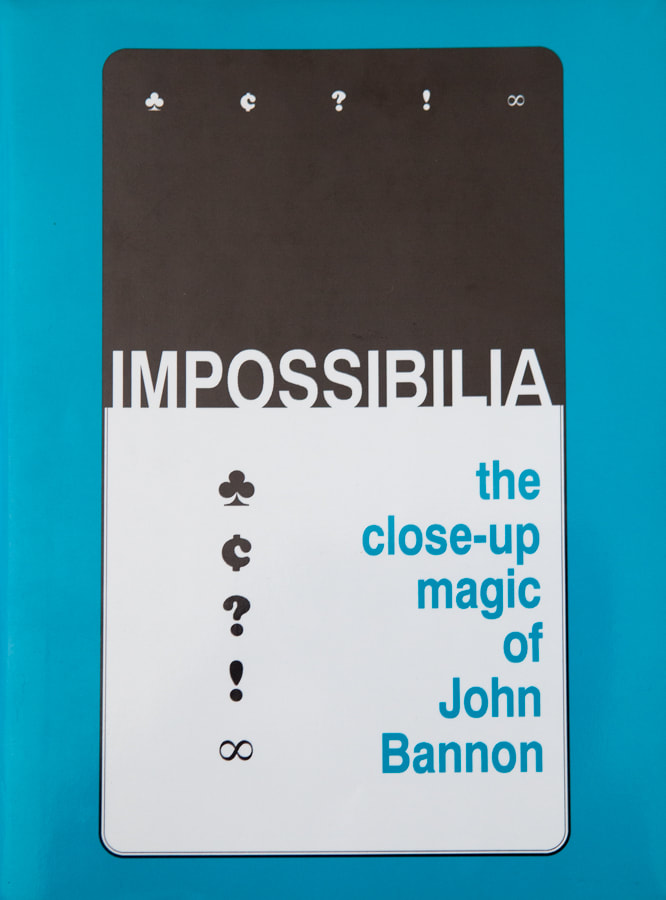
 RSS Feed
RSS Feed